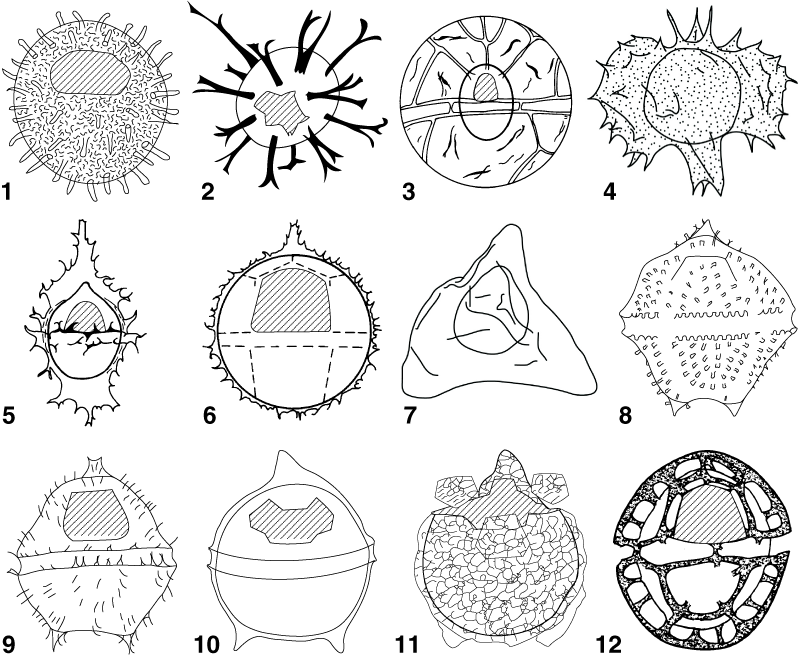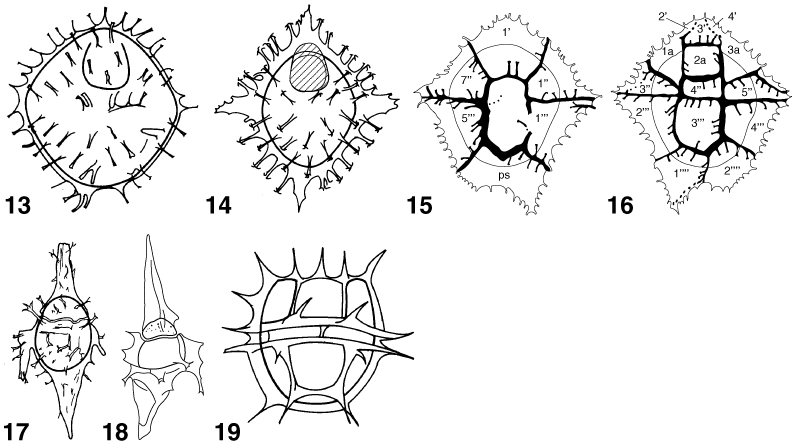
Plate P10. The modified Kofoid system (as outlined in Fensome et al., 1993b) is used in the labeling of individual plates for the gonyaulacaleans. The Kofoid system is used in the labeling of plates in the peridinialeans. The archeopyle location is denoted by diagonal lines. 1. Sumatradinium soucouyantiae de Verteuil and Norris 1992. Dorsal view. Holotype dimensions: mid-body length (excluding processes) = 87 Ám, equatorial diameter = 75 Ám, process length (based on 15 specimens) = 6–15 Ám. 2. Surculosphaeridium? longifurcatum (Firtion 1952) Davey et al. 1966. Oblique apical view. Holotype dimensions: central body diameter = 41 Ám, process length = 20 Ám. 3. Thalassiphora delicata Williams and Downie 1966c. Dorsal view. Holotype dimensions: overall diameter = 74 Ám x 75 Ám, endocyst diameter = 34 Ám x 43 Ám. 4. Thalassiphora? spinosa (Clarke and Verdier 1967) Foucher 1975. Holotype dimensions: overall diameter = 93 Ám, endocyst diameter = 38 Ám, process length = 5–12 Ám. 5. Triblastula utinensis O. Wetzel 1933b. Dorsal view. Range of type material: length = 100–112 Ám, width = 45–50 Ám. 6. Trichodinium castanea Deflandre 1935 ex Clarke and Verdier 1967. Dorsal view. Holotype dimensions: overall length = 89 Ám, overall width = 73 Ám, apical horn length = 11 Ám. 7. Trigonopyxidia ginella (Cookson and Eisenack 1960a) Downie and Sarjeant 1965. Lateral view. Holotype dimensions: pericyst diameter = 50 Ám, endocyst diameter = 30 Ám. 8. Trinovantedinium applanatum (Bradford 1977) Bujak and Davies 1983. Dorsal view. Holotype dimensions: overall length = 78 Ám, overall width = 74 Ám, distance between antapical horns (distally) = 25 Ám, maximum height of processes = 2.5 Ám. 9. Trinovantedinium glorianum (Head et al. 1989b) de Verteuil and Norris 1992. Dorsal view. Holotype dimensions: pericyst length (including processes) = 63 Ám, endocyst length = 52 Ám, process length (based on 12 specimens) = 2.5–8 Ám. 10. Trithyrodinium evittii Drugg 1967. Dorsal view. Range of type material: cyst length = 75–95 Ám, cyst width = 60–80 Ám. 11. Trithyrodinium suspectum (Manum and Cookson 1964) Davey 1969b. Dorsal view. Holotype dimensions: overall length = 118 Ám, endocyst diameter = 73 Ám. 12. Unipontidinium aquaeductum (Piasecki 1980) Wrenn 1988. Dorsal view. Holotype dimensions: overall length = 39 Ám, overall width = 38 Ám, central body length = 27 Ám, central body width = 26 Ám. 13. Wetzeliella gochtii Costa and Downie 1976. Dorsal view. Holotype dimensions: pericyst length = 113 Ám, pericyst width = 108 Ám, endocyst length = 97 Ám, endocyst width = 93 Ám, apical horn length = 0 Ám, lateral horn length = 6 Ám, right antapical horn length = 10 Ám, left antapical horn length = 6 Ám, process length = 6–15 Ám. 14. Wetzeliella meckelfeldensis Gocht 1969. Dorsal view. Holotype dimensions: pericyst length = 151 Ám, pericyst width = 140 Ám, endocyst diameter = 83.75 Ám. 15, 16. Wilsonidium echinosuturatum (Wilson 1967c) Lentin and Williams 1976. Holotype dimensions: pericyst length = 149 Ám, pericyst width = 143 Ám, endocyst diameter = 99 Ám x 91 Ám, apical horn length = 14 Ám, left antapical horn length = 11 Ám, right antapical horn length = 22 Ám, lateral horns = 16 Ám; (15) ventral view; (16) dorsal view. 17, 18. Xenascus ceratioides (Deflandre 1937b) Lentin and Williams 1973. Holotype dimensions: pericyst length = 172 Ám; (17) ventral view; (18) dorsal view. 19. Xiphophoridium alatum (Cookson and Eisenack 1962b) Sarjeant 1966b. Dorsal view. Holotype dimensions: overall length = 125 Ám, overall width = 96 Ám, length (not including ornamentation) = 70 Ám, width (not including ornamentation) = 52 Ám.





![]()